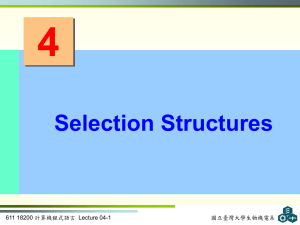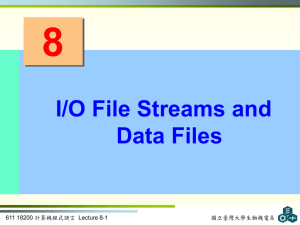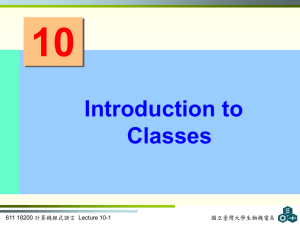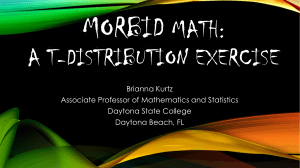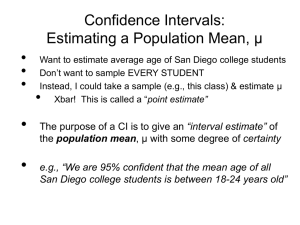Document
advertisement
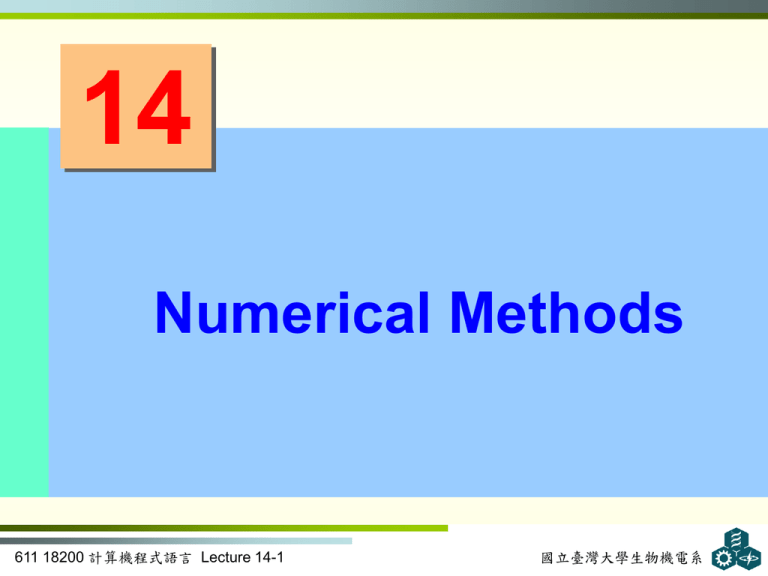
14 Numerical Methods 611 18200 計算機程式語言 Lecture 14-1 國立臺灣大學生物機電系 Contents • • • • • • • • Root finding The bisection method Refinements to the bisection method The secant method Numerical integration The trapezoidal rule Simpson’s Rule Common programming errors 611 18200 計算機程式語言 Lecture 14-2 國立臺灣大學生物機電系 Introduction to Root Finding • Root finding is useful in solving engineering problems • Vital elements in numerical analysis are: – Appreciating what can or can’t be solved – Clearly understanding the accuracy of answers found 611 18200 計算機程式語言 Lecture 14-3 國立臺灣大學生物機電系 Introduction to Root Finding • Examples of the types of functions encountered in root-solving problems: 611 18200 計算機程式語言 Lecture 14-4 國立臺灣大學生物機電系 Introduction to Root Finding • General quadratic equation, Equation 14.1, can be solved easily and exactly by using the following equation: 611 18200 計算機程式語言 Lecture 14-5 國立臺灣大學生物機電系 Introduction to Root Finding • Equation 14.2 can be solved for x exactly by factoring the polynomial • Equation 14.4 and 14.5 are transcendental equations • Transcendental equations – Represent a different class of functions – Typically involve trigonometric, exponential, or logarithmic functions – Cannot be reduced to any polynomial equation in x 611 18200 計算機程式語言 Lecture 14-6 國立臺灣大學生物機電系 Introduction to Root Finding • Irrational numbers and transcendental numbers – Represented by non-repeating decimal fractions – Cannot be expressed as simple fractions – Responsible for the real number system being dense or continuous • Classifying equations as polynomials or transcendental and the roots of these equations as rational or irrational is vital to traditional mathematics – Less important to the computer where number system is continuous and finite 611 18200 計算機程式語言 Lecture 14-7 國立臺灣大學生物機電系 Introduction to Root Finding • When finding roots of equations, the distinction between polynomials and transcendental equations is unnecessary • Many theorems learned for roots and polynomials don’t apply to transcendental equations – Both Equations 14.4 and 14.5 have infinite number of real roots 611 18200 計算機程式語言 Lecture 14-8 國立臺灣大學生物機電系 Introduction to Root Finding • Potential computational difficulties can be avoided by providing: – Best possible choice of method – Initial guess based on knowledge of the problem • This is often the most difficult and time consuming part of solution – Art of numerical analysis consists of balancing time spent optimizing the problem’s solution before computation against time spent correcting unforeseen errors during computation 611 18200 計算機程式語言 Lecture 14-9 國立臺灣大學生物機電系 Introduction to Root Finding • Sketch function before attempting root solving – Use graphing routines or – Generate table of function values and graph by hand • Graphs are useful to programmers in: – Estimating first guess for root – Anticipating potential difficulties 611 18200 計算機程式語言 Lecture 14-10 國立臺灣大學生物機電系 Introduction to Root Finding Figure 14.1 Graph of e-x and sin(½πx) for locating the intersection points 611 18200 計算機程式語言 Lecture 14-11 國立臺灣大學生物機電系 Introduction to Root Finding • Because the sine oscillates, there is an infinite number of positive roots • Concentrate on improving estimate of first root near 0.4 • Establish a procedure based on most obvious method of attack – Begin at some value of x just before the root – Step along x-axis carefully watching magnitude and sign of function 611 18200 計算機程式語言 Lecture 14-12 國立臺灣大學生物機電系 Introduction to Root Finding • Notice that function changed sign between 0.4 and 0.5 – Indicates root between these two x values 611 18200 計算機程式語言 Lecture 14-13 國立臺灣大學生物機電系 Introduction to Root Finding • For next approximation use midpoint value, x = 0.45 • Function is again negative at 0.45 indicating root between 0.4 and 0.45 • Next approximation is midpoint, 0.425 611 18200 計算機程式語言 Lecture 14-14 國立臺灣大學生物機電系 Introduction to Root Finding • In this way, proceed systematically to a computation of the root to any degree of accuracy • Key element in this procedure is monitoring the sign of function • When sign changes, specific action is taken to refine estimate of root 611 18200 計算機程式語言 Lecture 14-15 國立臺灣大學生物機電系 The Bisection Method • Root-solving procedure previously explained is suitable for hand calculations • A slight modification makes it more systematic and easier to adapt to computer coding • Modified computational technique is known as the bisection method – Suppose you already know there’s a root between x = a and x = b • Function changes sign in this interval – Assume • Only one root between x = a and x = b • Function is continuous in this interval 611 18200 計算機程式語言 Lecture 14-16 國立臺灣大學生物機電系 The Bisection Method Figure 14.2 A sketch of a function with one root between a and b 611 18200 計算機程式語言 Lecture 14-17 國立臺灣大學生物機電系 The Bisection Method • After determining a second time whether the left or right half contains the root, interval is again replaced by the left or right half-interval • Continue process until narrow in on the root at previously assigned accuracy • Each step halves interval – After n intervals, interval’s size containing root is • (b – a)/2n 611 18200 計算機程式語言 Lecture 14-18 國立臺灣大學生物機電系 The Bisection Method • If required to find root to within the tolerance, the number of iterations can be determined by: 611 18200 計算機程式語言 Lecture 14-19 國立臺灣大學生物機電系 The Bisection Method • Program 14.1 computes roots of equations • Note following features: – In each iteration after the first one, there is only one function evaluation – Program contains several checks for potential problems along with diagnostic messages along with diagnostic messages – Criterion for success is based on interval’s size 611 18200 計算機程式語言 Lecture 14-20 國立臺灣大學生物機電系 Refinements to the Bisection Method • Bisection method presents the basics on which most root-finding methods are constructed – Brute-force is rarely used • All refinements of bisection method attempt to use as much information as available about the function’s behavior in each iteration • In ordinary bisection method only feature of function monitored is its sign 611 18200 計算機程式語言 Lecture 14-21 國立臺灣大學生物機電系 Regula Falsi Method • Essentially same as bisection method, except it uses interpolated value for root • Root is known to exist in interval ( x1 ↔ x2 ) • In drawing, f1 is negative and f3 is positive • Interpolated position of root is x2 • Length of sides is related, yielding: • Value of x2 replaces the midpoint in bisection 611 18200 計算機程式語言 Lecture 14-22 國立臺灣大學生物機電系 Regula Falsi Method Figure 14.3 Estimating the root by interpolation 611 18200 計算機程式語言 Lecture 14-23 國立臺灣大學生物機電系 Regula Falsi Method Figure 14.4 Illustration of several iterations of the regula falsi method 611 18200 計算機程式語言 Lecture 14-24 國立臺灣大學生物機電系 Modified Regula Falsi Method • Perhaps the procedure can be made to collapse from both directions from both directions • The idea is as follows: 611 18200 計算機程式語言 Lecture 14-25 國立臺灣大學生物機電系 Modified Regula Falsi Method Figure 14.5 Illustration of the modified regula falsi method 611 18200 計算機程式語言 Lecture 14-26 國立臺灣大學生物機電系 Modified Regula Falsi Method • Using this algorithm, slope of line is reduced artificially • If root is in left of original interval, it: – Eventually turns up in the right segment of a later interval – Subsequently alternates between left and right 611 18200 計算機程式語言 Lecture 14-27 國立臺灣大學生物機電系 Modified Regula Falsi Method Table 14.1 Comparison of Root-Finding Methods Using the Function f(x)=2e-2x -sin(πx) 611 18200 計算機程式語言 Lecture 14-28 國立臺灣大學生物機電系 Modified Regula Falsi Method • Relaxation factor: Number used to alter the results of one iteration before inserting them into the next • Trial and error shows that a less drastic increase in the slope results in improved convergence • Using a convergence factor of 0.9 should be adequate for most problems 611 18200 計算機程式語言 Lecture 14-29 國立臺灣大學生物機電系 Summary of the Bisection Methods • Bisection – – – – – Success based on size of interval Slow convergence Predictable number of iterations Interval halved in each iteration Guaranteed to bracket a root 611 18200 計算機程式語言 Lecture 14-30 國立臺灣大學生物機電系 Summary of Bisection Methods • Regula falsi – – – – Success based on size of function Faster convergence Unpredictable number of iterations Interval containing the root is not small 611 18200 計算機程式語言 Lecture 14-31 國立臺灣大學生物機電系 Summary of Bisection Methods • Modified regula falsi – – – – Success based on size of interval Faster convergence Unpredictable number of iterations Of three methods, most efficient for common problems 611 18200 計算機程式語言 Lecture 14-32 國立臺灣大學生物機電系 The Secant Method • Identical to regula falsi method except sign of f(x) doesn’t need to be checked at each iteration 611 18200 計算機程式語言 Lecture 14-33 國立臺灣大學生物機電系 Introduction to Numerical Integration • Integration of a function of a single variable can be thought of as opposite to differentiation, or as the area under the curve • Integral of function f(x) from x=a to x=b will be evaluated by devising schemes to measure area under the graph of function over this interval – Integral designated as: 611 18200 計算機程式語言 Lecture 14-34 國立臺灣大學生物機電系 Introduction to Numerical Integration Figure 14.7 An integral as an area under a curve 611 18200 計算機程式語言 Lecture 14-35 國立臺灣大學生物機電系 Introduction to Numerical Integration • Numerical integration is a stable process – Consists of expressing the area as the sum of areas of smaller segments – Fairly safe from division by zero or round-off errors caused by subtracting numbers of approximately the same magnitude • Many integrals in engineering or science cannot be expressed in any closed form 611 18200 計算機程式語言 Lecture 14-36 國立臺灣大學生物機電系 Introduction to Numerical Integration • Trapezoidal rule approximation for integral – Replace function over limited range by straight line segments – Interval x=a to x=b is divided into subintervals of size ∆x – Function replaced by line segments over each subinterval – Area under function is then approximated by area under line segments 611 18200 計算機程式語言 Lecture 14-37 國立臺灣大學生物機電系 The Trapezoidal Rule • Approximation of area under complicated curve is obtained by assuming function can be replaced by simpler function over a limited range • A straight line, the simplest approximation to a function, lead to trapezoidal rule • Trapezoidal rule for one panel, identified as T0 611 18200 計算機程式語言 Lecture 14-38 國立臺灣大學生物機電系 The Trapezoidal Rule Figure 14.8 Approximating the area under a curve by a single trapezoid 611 18200 計算機程式語言 Lecture 14-39 國立臺灣大學生物機電系 The Trapezoidal Rule • Improve accuracy of approximation under curve by dividing interval in half – Function is approximated by straight-line segments over each half • Area in example is approximated by area of two trapezoids – Where 611 18200 計算機程式語言 Lecture 14-40 國立臺灣大學生物機電系 The Trapezoidal Rule Figure 14.9 Two-panel approximation to the area 611 18200 計算機程式語言 Lecture 14-41 國立臺灣大學生物機電系 The Trapezoidal Rule • Two-panel approximation T1 can be related to one-panel results, T0, as: • Result for n panels is: 611 18200 計算機程式語言 Lecture 14-42 國立臺灣大學生物機電系 Computational Form of the Trapezoidal Rule • Equation 14.9 was derived assuming widths of all panels the same and equal to ∆xn • Equation can be generalized to a partition of the interval into unequal panels • By restricting panel widths to be equal and number of panels to be a power of 2, 2∆x2 = ∆x1 • This results in: 611 18200 計算機程式語言 Lecture 14-43 國立臺灣大學生物機電系 Computational Form of the Trapezoidal Rule Figure 14.10 Four-panel trapezoidal approximation, T2 611 18200 計算機程式語言 Lecture 14-44 國立臺灣大學生物機電系 Computational Form of the Trapezoidal Rule Where 611 18200 計算機程式語言 Lecture 14-45 國立臺灣大學生物機電系 Computational Form of the Trapezoidal Rule • Procedure using Equation 14.11 to approximate an integral by the trapezoidal rule is: – Compute T0 by using Equation 14.6 – Repeatedly apply Equation 14.11 for: k = 1, 2, . . . until sufficient accuracy is obtained 611 18200 計算機程式語言 Lecture 14-46 國立臺灣大學生物機電系 Example of a Trapezoidal Rule Calculation • Given the following integral: • Trapezoidal rule approximation to the integral with a = 1 and b = 2 begins with Equation 14.6 to obtain T0 611 18200 計算機程式語言 Lecture 14-47 國立臺灣大學生物機電系 Example of a Trapezoidal Rule Calculation • Repeated use of Equation 14.11 then yields: 611 18200 計算機程式語言 Lecture 14-48 國立臺灣大學生物機電系 Example of a Trapezoidal Rule Calculation • Continuing the calculation through k = 5 yields 611 18200 計算機程式語言 Lecture 14-49 國立臺灣大學生物機電系 Simpson’s Rule • Trapezoidal rule is based on approximating the function by straight-line segments • To improve the accuracy and convergence rate, another approach is approximating the function by parabolic segments, known as Simpson’s rule • Specifying a parabola uniquely requires three points, so the lowest order Simpson’s rule has two panels 611 18200 計算機程式語言 Lecture 14-50 國立臺灣大學生物機電系 Simpson’s Rule Figure 14.11 Area under a parabola drawn through three points 611 18200 計算機程式語言 Lecture 14-51 國立臺灣大學生物機電系 Simpson’s Rule Where And 611 18200 計算機程式語言 Lecture 14-52 國立臺灣大學生物機電系 Simpson’s Rule Figure 14.12 The second-order Simpson’s rule approximation is the area under two parabolas 611 18200 計算機程式語言 Lecture 14-53 國立臺灣大學生物機電系 Simpson’s Rule • Generalization of Equation 14.12 for n = 2k panels 611 18200 計算機程式語言 Lecture 14-54 國立臺灣大學生物機電系 Example of Simpson’s Rule as an Approximation to an Integral • Consider this integral: • Using Equation 14.13 first for k = 1 yields: 611 18200 計算機程式語言 Lecture 14-55 國立臺灣大學生物機電系 Example of Simpson’s Rule as an Approximation to an Integral • Repeating for k = 2 yields: 611 18200 計算機程式語言 Lecture 14-56 國立臺灣大學生物機電系 Example of Simpson’s Rule as an Approximation to an Integral • Continuing the calculation yields: Figure 14.2 Trapezoidal and Simpson’s Rule Results for the Integral 611 18200 計算機程式語言 Lecture 14-57 國立臺灣大學生物機電系 Common Programming Errors • Two characteristics of this type of computation: – Round-off errors occur when the values of f(x1) and f(x3) are nearly equal – Prediction of exact number of iterations is not available • Excessive and possibly infinite iterations must be prevented • Excessive computation time might be a problem – Occurs if number of iterations exceeds fifty 611 18200 計算機程式語言 Lecture 14-58 國立臺灣大學生物機電系 Summary • All root solving methods described in chapter are iterative • Can be categorized into two classes – Starting from an interval containing a root – Starting from an initial estimate of a root • Bisection algorithms refine initial interval by: – Repeated evaluation of function at points within interval – Monitoring the sign of the function and determining in which subinterval the root lies 611 18200 計算機程式語言 Lecture 14-59 國立臺灣大學生物機電系 Summary • Regula falsi uses same conditions as bisection method – Straight line connecting points at the ends of the intervals is used to interpolate position of root – Intersection of this line with x-axis determines value of x2 used in next step • Modified regula falsi same as regula falsi except: – In each iteration when full interval replaced by subinterval containing root, relaxation factor used to modify function’s value at the fixed end of the subinterval 611 18200 計算機程式語言 Lecture 14-60 國立臺灣大學生物機電系 Summary • Secant method replaces the function by: – Secant line through two points – Finds point of intersection of the line with x-axis • Algorithm requires two input numbers: – x0 and ∆x0 • Pair of values then replaced by pair (x1, and ∆x1) where x1 = x0 + ∆x0 and 611 18200 計算機程式語言 Lecture 14-61 國立臺灣大學生物機電系 Summary • Secant method processing continues until ∆x is sufficiently small • Success of a program in finding the root of function usually depends on the quality of information supplied by the user – Accuracy of initial guess or search interval – Method selection match to circumstances of problem • Execution-time problems are usually traceable to: – Errors in coding – Inadequate user-supplied diagnostics 611 18200 計算機程式語言 Lecture 14-62 國立臺灣大學生物機電系 Summary • Trapezoidal rule results from replacing the function f(x) by straight-line segments over the panels ∆xi • Approximate value for integral is given by following formula 611 18200 計算機程式語言 Lecture 14-63 國立臺灣大學生物機電系 Summary • If panels are equal size and the number of panels is n = 2k where k is a positive integer, the trapezoidal rule approximation is then labeled Tk and satisfies the equation where 611 18200 計算機程式語言 Lecture 14-64 國立臺灣大學生物機電系 Summary • In next level of approximation – Function f(x) is replaced by n/2 parabolic segments over pairs of equal size panels, ∆x = (b - a)/n – Results in formula for the area known as Simpson’s rule: 611 18200 計算機程式語言 Lecture 14-65 國立臺灣大學生物機電系
